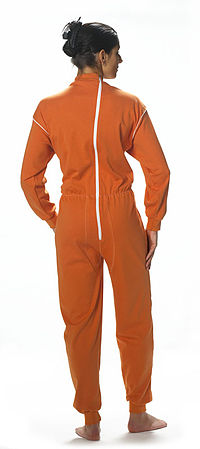- Locking clothing
-
Locking clothing is designed to prevent wearers from disrobing when doing so is inappropriate. Those who may need such clothes include older adults with old-age conditions such as Alzheimer's Disease, or younger adults and children with disorders from birth.
Commonly, adaptive clothes that are made with this accommodation are one-piece jumpsuits that feature back zippers. In many cases, they are made with zippers that have one or more unusual features in order to make them unlike regular clothes, and therefore harder to remove.
Some alternative closures on these jumpsuits include zippers that zip from top to bottom (they are separating zippers similar to those found on coats) and tuck into a small pocket found below waist level.
Other zippers may be off-center in order to be in a location in which the patient is not used to finding it.
Contents
Mousetraps
Sometimes, as an alternative to special clothes, special devices at a lower price can be attached to regular clothes in order to prevent a person from removing the clothes. Though many names are used for these objects, they are sometimes referred to as "mousetraps." Many versions exist, some of which are also designed to have fashionability.
While in most cases, these devices are manufactured for use with persons with special medical needs, they are occasionally used by fetishists[citation needed].
Types of devices
Button cover
A button cover is an object larger than the button that it covers, and closes over the button, thereby making the button too large to pass through its hole. These, however, have the weakness in which the button can be removed from the garment with enough force, thereby making it less effective, and damaging the garment when it is breached.
Some button covers, especially those that attach to neck-level buttons, are sometimes designed to look somewhat fashionable.
Buttonhole blocks
A buttonhole blocker holds the fabric at the two sides of the buttonhole together, thereby making the buttonhole too small for the button to pass through. While more secure than a button cover, it is much harder to apply, and does not have such a fashionable appearance.
Zipper blocker
A zipper blocker prevents the zipper from sliding down its shaft. One version is a locking safety pin in which a piece of the metal bar simply rests across the shift, thereby blocking movement of the zipper's channel in that direction. Other versions, which are sewn onto the garment, involve two pieces of metal that hook together, and likewise block the zipper's movement.
Other versions have been created that hold the pull tab on the zipper in place.
In many care facilities, common safety pins are used rather than special purchases of these devices being made.
Thigh rings
A less common device is a pair of thigh rings, which secure around the legs below the genital area. This allows the pants to be pulled down far enough for toileting, but prevents them from being removed, and does not reduce comfort.
Waistbelt
Special waistbelts have been developed that hold the shirt and pants together. This prevents the patient from pulling up his/her shirt or pulling down his/her pants.
See also
External links
- [The Institute-warning adult content[1]]
Health care Economics · Equipment · Guidelines · Industry · Philosophy · Policy · Providers · Ranking · Reform · SystemProfessions Settings Care Skills / Training Categories:- Physical restraint
- Protective gear
- Safety clothing
Wikimedia Foundation. 2010.

